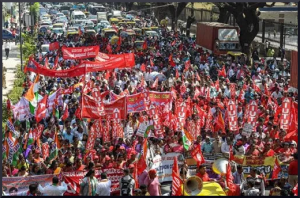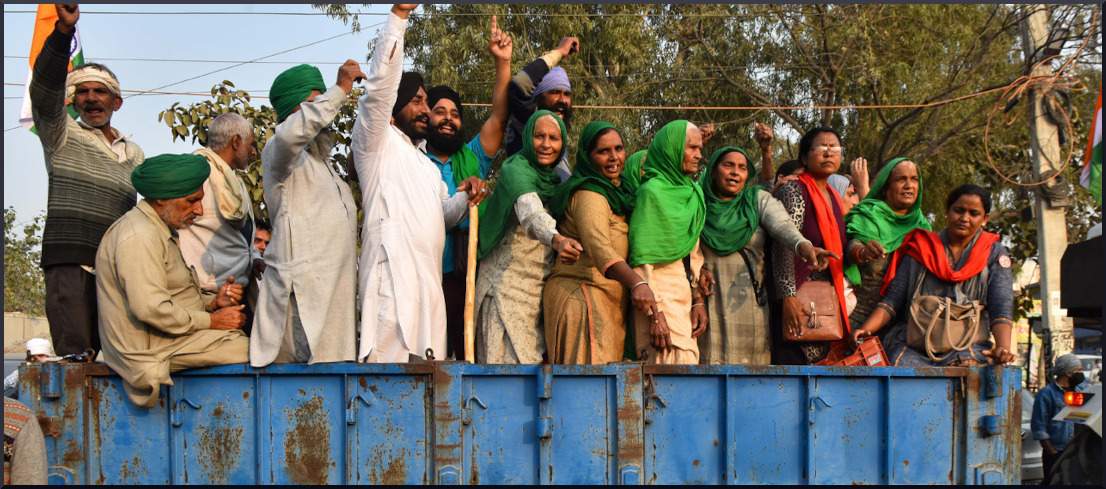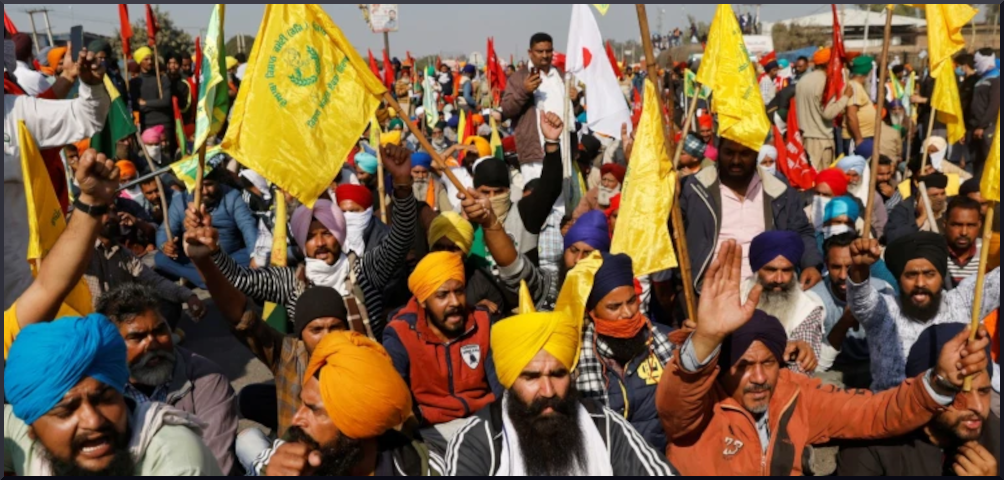by Marty Goodman, published on Socialist Action, January 15, 2021
As many as 250 million in India were on strike Nov. 26 against the right-wing policies of Prime Minister Narendra Modi and his Hindu chauvinist Bharatiya Janata Party’s (BJP) – the biggest strike in world history! The struggle mobilized millions of farmers – thousands of them on tractors – joined by striking workers and students across India for the biggest protest in world history.
 The protesters were enraged at Modi’s three new laws that favor agribusiness over small farmers, a threat to the survival of India’s impoverished rural workforce. Modi’s changes undermine long-standing governmental measures that stabilize crop prices in the form of a Minimum Support Price and limits to corporate hording and price gouging. The changes, pitched as eliminating red-tape, encourage monopoly agribusiness and ultimately food export, policies favored by the World Bank and U.S. imperialism. The changes were rammed through last September.
The protesters were enraged at Modi’s three new laws that favor agribusiness over small farmers, a threat to the survival of India’s impoverished rural workforce. Modi’s changes undermine long-standing governmental measures that stabilize crop prices in the form of a Minimum Support Price and limits to corporate hording and price gouging. The changes, pitched as eliminating red-tape, encourage monopoly agribusiness and ultimately food export, policies favored by the World Bank and U.S. imperialism. The changes were rammed through last September.
India’s COVID-19 pandemic, second only to the U.S. in COVID deaths, resulted in tens of millions losing their jobs, which Modi saw as an “opportunity in crisis,” a ready excuse to enact a ruthless “disaster capitalism” free-market economic plan favorable to his billionaire pals.
Crisis of Indian agriculture
The Nov. 26 mobilization was organized by 10 national trade unions, which includes 300 farmers’ organizations and smaller labor groups. It outlined 12-points of agreement: reverse the recent government repeal of labor and farm price protections; end the privatization of public companies, and relief from India’s sharp economic crisis.
Some 60% of India’s population, 1.3 billion, own small farms or are agricultural workers. 85% own less than 5 acres, and, of that women own only 13%, leaving them most vulnerable to corporations. Neo-liberal policies, begun in earnest in the ‘90’s, saw the collapse of fuel subsidizes, the increasing cost of fertilizers and pesticides, making small farming extremely difficult. 50% of all children suffered malnutrition before COVID. Reflecting the extreme crisis of Indian agriculture, estimates of farmer and wage laborer suicides in 2019 run from over 10,000 to 42,480. Five farmers committed suicide during the recent protests alone.
Said one protesting farmer,
“I am a small farmer but land is my mother. It never leaves us hungry. How can we abandon it? As far as this struggle is concerned, we are sure we will win this struggle. Nobody has witnessed this kind of movement here, where people from all castes and religions have come forward to fight unjust laws.”
Said one worker at the protests,
“We are barely able to survive, ground down between price rises on the one hand and low wages on the other. Now, they have changed labor laws so that employers are sitting on our chests,”
referring to the new Labor Codes that have relaxed rules for firing workers, emboldening bosses, and made union activism difficult.
Government repression
In one video, a protester told a cop, “this is a revolution, sir.” The protesters were frequently met with clubs, water cannons, police barricades and arrests as they headed toward New Delhi, set to conclude in a massive march and tractor procession on the capital Jan. 26, Republic Day, a day of celebration of India’s “democratic” constitution. Aiming to stop the rally, the government has filed an affidavit in the Supreme Court, where it claimed disruption of the Republic Day parade will be an “embarrassment to the nation.” In the meanwhile, thousands protest daily across India. As of this writing (Jan. 13), tens of thousands have set up camp in New Delhi in anticipation of the Republic demonstration.
The Jan. 9 New York Times reported,
“The farmers have turned a roughly 10-mile stretch of highway into the site of a well-organized community. Many of the farmers are Sikh, and they said their beliefs and sense of tradition had helped them make the sacrifices to sustain the protests.”
BJP leaders have used terms against the farmers from calling them agents of Pakistan and China to being Sikh separatists to being picnickers enjoying chicken biryani to being purveyors of bird flu to being looters and thieves.
As many as 60 of the peaceful protesters have died, five by suicide and others from illness and winter conditions. On Jan. 12th, India’s Supreme Court issued a hold on implementation of the new laws pending ongoing negotiations with the mass peasant and worker movements, a clear sign that the massive protests have India’s rulers worried. During the hearing, the Supreme Court said that it may set up of a committee to find ways to resolve the impasse.
Reacting to this proposal, Samyukt Kisan Morcha, an umbrella body of 40 farmer unions, expressed disappointment at the denial of an opportunity to present arguments about a Supreme Court committee. They said,
“While all organizations welcome the suggestions of the Hon’ble Supreme Court to stay the implementation of the farm laws, they are collectively and individually not willing to participate in any proceedings before a committee that may be appointed by the Honorable Supreme Court.”
Farmers are demanding that a special session of Parliament be convened and the new farm laws abolished.
Small farmers vs. agribusiness combines
Nevertheless, negotiations with the government seem to be ongoing.
Modi’s agricultural “reforms” follow economic models favored by the U.S. controlled World Bank which promote an agribusiness export model, one that deprives populations of domestically produced nutritious foods; essentially feeding the West but leaving underdeveloped countries dependent on Western “aid” and thereby ripe for political manipulation.

Developments in Indian agriculture mirror the international crisis of farming and the ever-encroaching takeover of small family holdings by giant agribusiness combines. An estimated 70% of all farmland around the world is controlled by only 1% of farms.In the U.S., small farmers have long suffered from government policies of deregulating and privatizing the agricultural sector.
During the 20th century, Black farmers lost 90% of their farmland to policies that consolidated land and subsidized corporate agribusinesses. In addition, the Equal Justice Initiative reports that “illegal pressures applied through USDA loan programs created massive transfers of wealth from Black to white farmers in the period just after the 1950s.” Federal agencies denied small farmers loans and foreclosed on minority farmers’ lands while limiting access to legal protections against predatory corporate practices.
Narendra Modi: Right-Wing Bigot Although Modi is a Trump-style racist bully the orientation of the Obama-Biden administration was to play India against its Chinese competitor in a U.S. “tilt toward Asia.” That will remain despite any occasional wrist slappings over Modi’s human rights record, which includes his adherence to the fascistic “Hindutva” Hindu supremacist ideology which devalues Muslims as disloyal to the Hindu majority and as “terrorists.” Modi is a long-time member of the Rashtriya Swayamsevak Sangh (RSS), an extremist Hindu nationalist organization. As Chief Minister of the state of Gujarat in 2002, Modi oversaw pogroms against Muslims that left an estimated 2,000 people dead.
In Dec. 2019, Modi enacted the anti-Muslim Citizenship Amendment Act (CAA), an anti-Muslim naturalization law. Under the CAA, Hindu, Sikh, Jain, Parsi and Christian minorities from neighboring Bangladesh, Pakistan and Afghanistan are eligible to become citizens, if they came to India before Dec. 31, 2014. Muslims were not included. Massive protests followed, which resulted in widespread police brutality and thousands of arrests.
The ongoing struggle
Thus far, the mass movement leaderships have not back peddled on demanding the complete reversal of the three agricultural laws, a good sign of unity. Many have also noted the profound unity in action between Hindu, Muslim, Sikh, etc. protesters as well as members of different castes, including the doubly oppressed Dalits (Untouchables) and other “scheduled” classes, an especially sharp rebuke to Modi and his BJP bigots!
Yet, to be most effective the mass strikes and mobilizations need to be ongoing, not one-day actions and take on a permanent character to defeat the neo-liberal onslaught.
Nor can this crisis be solved by the electoral removal of Modi, and in particular, by electoral blocks with capitalist parties like the Congress Party, an essential prop of the Indian order. Such alliances with the class enemy – even as a temporary electoral block against Modi – can only hold back the working-class struggle.
Ultimately, only the overthrow of a heartless capitalist system in the throes of crisis and its replacement by a worker’s revolution can truly end the appalling misery of the Indian masses. Necessary is the task of a yet to be constructed revolutionary party.
Since November there have been international solidarity protests, including in the United States, Canada, the UK, Australia, and New Zealand, but more needs to be done. The entire international labor movement must ramp-up its solidarity with the epic struggle unfolding in India today. A defeat in India is a defeat for us all. Workers of the world unite – as true as ever!
*Featured Image: Farmers from the northern Indian states of Punjab and Haryana, angry at recently enacted farm laws, have been trying to stage protests in the capital, New Delhi [FIle: Danish Siddiqui/Reuters]

Marty Goodman has written a most informative article that shows the critical importance of broad based solidarity, mass action and activist unions if we are to build a world in which justice prevails. If anyone reading this article is drinking, or thinking about consuming a Coca-Cola beverage, they should know that Coca-Cola has been a leader in causing grief for many Indian farmers and communities because of its overexploitation and toxic pollution of scarce water resources leading to “farmlands being turned into wastelands. KillerCoke….Unthinkable, Undrinkable!
Thank you UNAC for the work you do and for publishing this article.